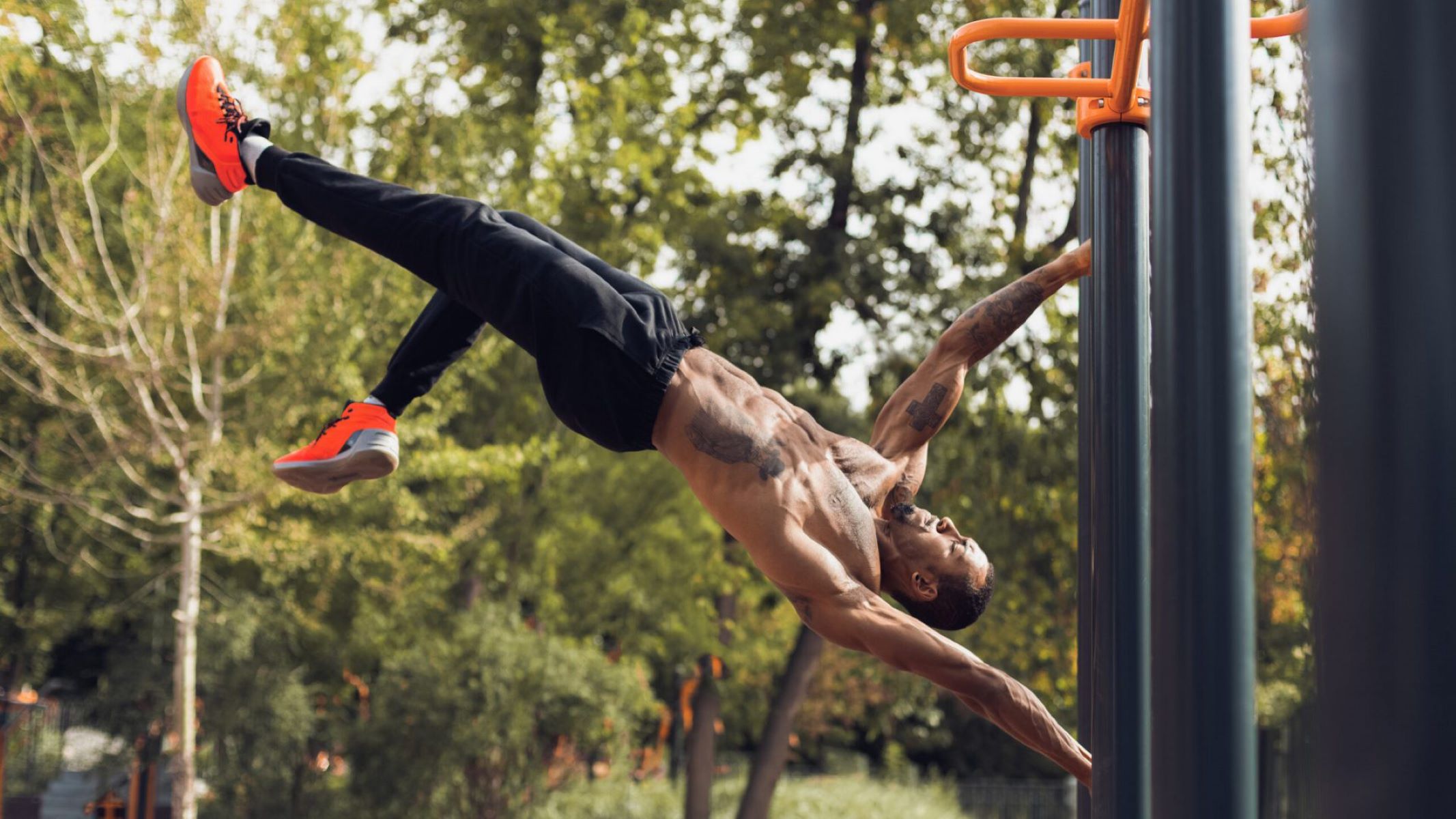

Featured
What Is Calisthenics Workout
Modified: January 22, 2024
Discover the benefits of calisthenics workout and how it can enhance your fitness routine. Get featured in our exclusive training programs designed to optimize your strength and endurance.
Introduction
Are you looking for a workout routine that doesn’t require expensive gym memberships or fancy equipment? Look no further than calisthenics. Calisthenics is a form of exercise that utilizes your body weight to build strength, increase flexibility, and improve overall fitness. It is a versatile and accessible workout option that can be done anywhere, anytime.
Calisthenics, also known as bodyweight training, has gained tremendous popularity in recent years due to its simplicity and effectiveness. Unlike traditional weightlifting, calisthenics focuses on using your own body as resistance to target specific muscle groups. This not only helps in building lean muscle mass but also improves functional strength and stability.
One of the main benefits of calisthenics is the wide range of exercises that can be performed. From basic movements like push-ups and squats to advanced exercises like human flags and muscle-ups, there is a progression suitable for individuals of all fitness levels. This makes calisthenics suitable for beginners and seasoned athletes alike.
Another advantage of calisthenics is its ability to improve balance, coordination, and flexibility. As you engage multiple muscle groups simultaneously, you develop better body control and enhance your range of motion. These improvements are not only beneficial for your workout performance but also carry over to your daily activities.
In addition to strength and flexibility, calisthenics workouts can also provide cardiovascular benefits. By performing exercises in a circuit or at a high intensity, you can elevate your heart rate and improve endurance. This makes calisthenics an excellent option for individuals looking to improve their cardiovascular fitness without running on a treadmill for hours.
Whether you are a beginner looking to start your fitness journey or an experienced athlete wanting to take your training to the next level, calisthenics offers a fun and challenging workout routine. In the following sections, we will delve deeper into the definition of calisthenics, the benefits it offers, and various exercises for different fitness levels. Get ready to discover the power of bodyweight training and transform your physique and fitness.
Definition of Calisthenics Workout
Calisthenics is a form of exercise that focuses on using your own body weight to build strength, flexibility, and endurance. It is a versatile training method that is suitable for individuals of all fitness levels. Unlike weightlifting or using gym machines, calisthenics utilizes basic movements that engage multiple muscle groups simultaneously.
Calisthenics workouts typically involve exercises such as push-ups, squats, lunges, planks, and burpees. These exercises require little to no equipment, making them accessible to anyone, anywhere. The primary goal of calisthenics is to improve overall fitness by increasing muscle strength and definition, enhancing flexibility, and boosting cardiovascular endurance.
What sets calisthenics apart from other forms of exercise is its focus on mastering bodyweight movements. Rather than relying on external weights, calisthenics uses your body as resistance to challenge and strengthen various muscle groups. The movements are performed in a controlled manner, emphasizing proper form and technique.
Calisthenics workouts can be customized to suit individual preferences and goals. They can be adapted for beginners, intermediate or advanced fitness levels by modifying the intensity, duration, and variety of exercises. Whether you are looking to lose weight, build muscle, or improve athletic performance, calisthenics can be tailored to meet your specific needs.
In addition to its physical benefits, calisthenics also promotes mental well-being. The focus required to perform the exercises, as well as the sense of accomplishment when progressing in skills, can help relieve stress and improve cognitive function.
Overall, calisthenics offers a comprehensive and effective workout regimen that combines strength training, flexibility, and cardiovascular endurance. Its accessibility, versatility, and effectiveness have made it a popular choice among fitness enthusiasts around the world. So, if you’re looking for a workout routine that can be done anytime, anywhere, with minimal equipment, give calisthenics a try and experience the transformative power of bodyweight training.
Benefits of Calisthenics Workout
Calisthenics workouts offer a wide range of benefits for both the body and mind. Whether you are a beginner starting your fitness journey or an experienced athlete looking to switch up your training routine, incorporating calisthenics into your workout regimen can lead to numerous positive outcomes. Let’s dive into the benefits of calisthenics:
- Strength Building: Calisthenics exercises, such as push-ups, pull-ups, and squats, target multiple muscle groups simultaneously. By consistently challenging your body with these movements, you can build strength and develop lean muscle mass. The progressive nature of calisthenics allows you to gradually increase the difficulty of exercises, keeping your muscles consistently challenged and promoting steady growth.
- Improved Flexibility: Many calisthenics exercises require a full range of motion, helping to improve flexibility and joint mobility. Movements like lunges, planks, and the various stretches often incorporated in calisthenics routines can increase flexibility in the hips, shoulders, and other areas of the body. Enhanced flexibility not only improves your athletic performance but also decreases the risk of injuries from physical activities and daily movements.
- Increased Endurance: Calisthenics workouts can enhance cardiovascular endurance as well. By performing exercises in a circuit or incorporating high-intensity intervals, you can push your heart rate up and improve your stamina. This cardiovascular conditioning not only benefits your workout performance but also improves your daily activities, allowing you to tackle tasks with more energy and vigor.
- Weight Loss and Body Composition: Calisthenics workouts are effective for weight loss and body composition management. By engaging multiple muscle groups and performing compound exercises, you can increase your metabolic rate, burn calories, and promote fat loss. Additionally, as you build lean muscle mass through calisthenics, your body’s ability to burn calories at rest is increased, contributing to long-term weight management.
- Convenience and Accessibility: One of the greatest advantages of calisthenics is its convenience and accessibility. You don’t need expensive gym memberships or fancy equipment to perform calisthenics exercises. With just your bodyweight and minimal equipment like resistance bands or a pull-up bar, you can have a full-body workout anywhere – whether it’s at home, in a park, or while traveling.
- Functional Fitness: Calisthenics focuses on compound movements that mimic everyday activities, making it a great form of functional fitness. By incorporating exercises like squats, lunges, and push-ups, you can improve your strength, balance, and coordination, which translates into better performance in daily activities such as lifting objects, climbing stairs, or participating in sports.
Incorporating calisthenics into your fitness routine can bring about numerous benefits for your body and mind. Not only will you build strength, increase flexibility, and improve cardiovascular endurance, but you will also enjoy the convenience and adaptability of bodyweight training. So, whether you are a fitness enthusiast or just starting your fitness journey, give calisthenics a try and experience the holistic benefits it has to offer.
Basic Calisthenics Exercises
When starting with calisthenics, it’s essential to establish a strong foundation by mastering basic exercises. These exercises form the building blocks of your calisthenics journey and help you develop strength, stability, and body control. Here are some of the fundamental calisthenics exercises to incorporate into your workout routine:
- Push-ups: Push-ups are a classic calisthenics exercise that targets the chest, shoulders, triceps, and core. Start in a plank position with your hands shoulder-width apart. Lower your body until your chest is just above the ground, and then push back up to the starting position. Modify the exercise by performing knee push-ups or elevate your hands on an elevated surface to make it easier.
- Squats: Squats are great for targeting the lower body, including the quadriceps, hamstrings, and glutes. Begin with your feet shoulder-width apart and lower your body as if sitting back into a chair. Keep your chest up, and maintain a straight back throughout the movement. Push through your heels to return to the starting position. To make squats easier, perform assisted squats using a chair or TRX straps.
- Lunges: Lunges engage the quadriceps, hamstrings, glutes, and calves. Take a step forward with one foot and lower your body until both knees are at a 90-degree angle. Push back up to the starting position and alternate legs. To make lunges easier, perform reverse lunges by stepping backward instead of forward.
- Planks: Planks are excellent for building core strength and stability. Start by balancing on your forearms and toes, keeping your body in a straight line. Hold the position for as long as possible, focusing on engaging your abs and maintaining a neutral spine. Modify planks by performing them on your knees or using an elevated surface to support your upper body.
- Supermans: Supermans target your lower back and glutes. Lie face down on the ground with your arms extended overhead. Lift your arms, chest, and legs off the ground simultaneously, squeezing your glutes. Hold for a couple of seconds before lowering back down. To make it easier, lift only your arms or legs one at a time.
- Mountain Climbers: Mountain climbers provide a cardio element while targeting the core, shoulders, and hip flexors. Start in a high plank position and bring one knee toward your chest, then quickly switch legs in a running motion. Keep your hips low and your core engaged throughout the exercise. Perform these at a faster pace to increase intensity.
These basic calisthenics exercises provide a solid foundation for your workout routine. Start by mastering proper form and gradually increase the number of repetitions as you get stronger. Remember to listen to your body and take breaks as needed. As you progress, you can modify the exercises or add variations to keep challenging your muscles and advancing your skills.
Intermediate Calisthenics Exercises
Once you have established a solid foundation with basic calisthenics exercises, you can progress to more challenging movements to further develop your strength, mobility, and body control. These intermediate calisthenics exercises will take your training to the next level and continue to push your limits. Here are some intermediate exercises to incorporate into your workout routine:
- Pull-ups: Pull-ups are a staple exercise that targets the muscles of the back, biceps, and forearms. Start by hanging from a bar with your palms facing away from you and hands shoulder-width apart. Pull your body up until your chin clears the bar, then lower yourself back down with control. If you find pull-ups too challenging at first, use bands or an assisted pull-up machine for support.
- Dips: Dips primarily target the chest, triceps, and shoulders. Find parallel bars or use dip bars and position yourself between them. Lower your body by bending your elbows, keeping them close to your sides, until your upper arms are parallel to the ground. Push yourself back up to the starting position. To make dips easier, use a bench or elevated surface to reduce the range of motion.
- Pistol Squats: Pistol squats are a challenging single-leg squat variation that targets the quads, hamstrings, and glutes. Stand on one leg with the other leg extended in front of you. Lower your body while keeping your raised leg off the ground, and then push through your heel to return to the starting position. You can hold onto a railing or use a support for balance until you build enough strength and balance to perform them unassisted.
- L-sit: The L-sit is an advanced core exercise that targets the abs, hip flexors, and shoulders. Sit on the ground with your legs extended in front of you and your hands placed on the ground next to your hips. Lift your body off the ground by pressing through your hands and engage your core to keep your legs elevated in an L-shaped position. Start with bent knees and gradually work towards straightening your legs out in front of you.
- Handstand Push-ups: Handstand push-ups are an advanced exercise that targets the shoulders, triceps, and upper back. Begin in a handstand position against a wall or use parallel bars for support. Lower your body by bending your elbows until your head is just above the ground, then push back up to the starting position. Start with wall-assisted handstand push-ups and gradually progress to freestanding ones as you gain strength and balance.
- Dragon Flags: Dragon flags are an advanced exercise that targets the abs, hip flexors, and lower back. Lie on a bench or mat with your hands grasping the edge behind your head. Engage your core, lift your legs, and raise your hips to create a straight line from your head to your toes. Slowly lower your body back down while maintaining control. Start with bent knees and gradually work towards keeping your legs straight.
These intermediate calisthenics exercises will continue to challenge your strength, stability, and control. Remember to focus on proper form and technique and gradually increase the difficulty as you progress. Consistent practice and patience will help you master these movements and unlock a new level of strength and athleticism in your calisthenics journey.
Advanced Calisthenics Exercises
If you’re looking to take your calisthenics training to the next level and showcase your strength, agility, and control, it’s time to explore some advanced calisthenics exercises. These challenging movements require exceptional body control, balance, and muscular strength. Incorporate these advanced exercises into your workout routine to continue pushing your limits:
- Muscle-Ups: Muscle-ups are an impressive upper-body exercise that combines a pull-up and a dip. Start by performing a pull-up, then transition smoothly into a dip at the top of the movement. This exercise targets the back, shoulders, chest, and triceps. It requires both strength and technique. Begin by practicing on a bar or rings with lower rings for support until you develop the necessary strength to perform them without assistance.
- Dragon Flags: Dragon flags, popularized by Bruce Lee, are an advanced core exercise that targets the abs, hip flexors, and lower back. Lie on a bench or mat with your hands gripping the edge behind your head. Engage your core, lift your legs, and raise your hips to create a straight line from your head to your toes. Slowly lower your body back down while maintaining control. The dragon flag requires significant core strength and control.
- Human Flags: The human flag is an impressive display of upper-body and core strength. Begin by gripping a vertical post or bar with one hand placed above your head and the other hand holding onto the lower part of the post. Lift both feet off the ground and engage your core to hold your body horizontally, parallel to the ground. The human flag requires grip strength, shoulder stability, and intense core engagement.
- Front Lever: The front lever is a challenging exercise that targets the back, core, and shoulders. Start by hanging from a bar with an overhand grip. Engage your lats and core, and slowly raise your legs until your body is parallel to the ground, with your arms straight. Keep your body straight and maintain tension throughout the exercise. The front lever requires not only strength but also body control and stability.
- Planche: The planche is an advanced calisthenics exercise that requires immense upper-body strength and total body control. It involves balancing your body horizontally with straight arms, keeping your feet suspended off the ground. Achieving a planche takes time and consistent training, starting with tuck planches and progressing to advanced progressions as you build strength and stability.
- One-Arm Push-ups: One-arm push-ups are a challenging variation of the traditional push-up that targets the chest, shoulders, triceps, and core. Begin in a push-up position with your feet slightly wider for stability. Shift your weight to one side and lower your body by bending your elbow, keeping it close to the body. Push back up to the starting position. Start with fingertip push-ups or perform them with your hand elevated on an elevated surface until you build the necessary strength for a full one-arm push-up.
These advanced calisthenics exercises require a high level of strength, body control, and dedication to training. It’s important to progress gradually and prioritize proper form to avoid injuries. Remember to warm up adequately and listen to your body during training to ensure you’re pushing yourself safely and effectively.
As you master these advanced exercises, you’ll not only amaze others with your physical abilities but also gain a greater sense of confidence, discipline, and mental fortitude. Stay consistent, be patient, and enjoy the journey as you continue to push the boundaries of what your body is capable of in the world of calisthenics.
Calisthenics Workout Routine
Creating a well-rounded calisthenics workout routine is crucial for maximizing your progress and achieving your fitness goals. Whether you’re a beginner or an experienced calisthenics enthusiast, having a structured plan can help you stay focused and make consistent gains. Here’s a sample calisthenics workout routine that combines strength, flexibility, and endurance:
Warm-up:
- 5-10 minutes of light cardio, such as jogging or jumping jacks, to increase heart rate and warm up your muscles.
- Dynamic stretching exercises to loosen up major muscle groups, such as arm circles, leg swings, and torso twists.
Strength Training:
- Begin with 2-3 foundational exercises, such as push-ups or squats, performed in 3 sets of 10-12 repetitions each.
- Progress to more challenging exercises, such as pull-ups or pistol squats, performed in 3 sets of 8-10 repetitions each.
- Focus on maintaining proper form and technique throughout each exercise and gradually increase the difficulty or intensity as you get stronger.
Flexibility Training:
- Incorporate static stretching exercises to improve your flexibility and range of motion.
- Target major muscle groups, such as the hamstrings, quadriceps, and shoulders, and hold each stretch for 15-30 seconds.
- Include exercises like standing toe touch, seated butterfly stretch, and shoulder stretch to enhance your flexibility and decrease the risk of injuries.
Endurance/Cardio Training:
- Perform high-intensity interval training (HIIT) or circuit-style workouts to improve cardiovascular endurance and burn calories.
- Create a circuit of calisthenics exercises, such as burpees, mountain climbers, and jumping lunges, and perform each exercise for 30 seconds with a 15-second rest in between.
- Repeat the circuit for 3-4 rounds, gradually increasing the number of circuits as your fitness level improves.
Cooldown:
- Finish your workout with 5-10 minutes of light cardio, such as brisk walking or gentle cycling, to gradually lower your heart rate.
- Incorporate static stretches for all major muscle groups, holding each stretch for 15-30 seconds to promote muscle recovery and prevent muscle tightness.
Remember that this is just a sample calisthenics workout routine, and you can customize it based on your individual goals, fitness level, and time availability. Allow for a day or two of rest between workout sessions to allow your muscles to recover and adapt to the stress of the training.
Additionally, don’t forget to listen to your body and adjust the intensity or modify exercises as needed. Always prioritize proper form and technique to reduce the risk of injuries. As you progress, you can incorporate more advanced exercises, increase repetitions or sets, or explore new variations to challenge yourself and continue making progress.
Consistency is key for any workout routine to yield results. Stick to your calisthenics routine, track your progress, and celebrate your achievements along the way. With dedication and perseverance, you’ll be amazed at the strength, flexibility, and overall fitness you can achieve through calisthenics training.
Common Mistakes in Calisthenics Training
While calisthenics training offers numerous benefits, it’s important to be aware of common mistakes that can hinder progress or increase the risk of injury. By avoiding these pitfalls, you can make the most out of your calisthenics workouts and optimize your results. Here are some common mistakes to watch out for:
- Poor Form: One of the biggest mistakes in calisthenics training is sacrificing proper form for quantity or intensity. Performing exercises with incorrect form not only reduces their effectiveness but also increases the risk of injury. Focus on maintaining proper posture, engaging the correct muscles, and executing each movement with control and precision.
- Skipping Warm-up and Cool-down: Neglecting to warm up or cool down before and after your calisthenics workouts can lead to muscle strains, joint stiffness, and decreased flexibility. Take the time to incorporate dynamic stretching and light cardio warm-up to prepare your body for the workout. Similarly, include proper cooldown stretches to promote muscle recovery and prevent post-workout soreness.
- Overtraining: Pushing yourself too hard and training excessively without allowing adequate rest and recovery can lead to burnout, decreased performance, and increased risk of injuries. Your body needs time to repair and rebuild after challenging workouts. Incorporate rest days into your training schedule and listen to your body’s signals to avoid overtraining.
- Neglecting Mobility and Flexibility: Focusing solely on strength training without paying attention to mobility and flexibility can result in limited range of motion and increased susceptibility to injuries. Incorporate regular stretching exercises, foam rolling, and mobility drills to maintain joint health, improve flexibility, and enhance overall movement quality.
- Not Progressing Gradually: Progression is essential in calisthenics training to continue challenging your muscles and stimulating growth. Failing to progressively overload your workouts by increasing reps, sets, or exercise difficulty can lead to stagnation in your progress. Gradually increase the intensity, volume, or complexity of your exercises as you gain strength and confidence.
- Ignoring Core and Stabilizer Muscles: A strong core and stable joints are crucial for performing calisthenics exercises effectively. Neglecting to incorporate specific core exercises or failing to engage your core during compound movements can limit your progress and increase the risk of imbalances or injuries. Include exercises targeting the core and stabilizer muscles to enhance overall strength and stability.
- Not Listening to Your Body: Each individual is unique, and it’s important to listen to your body’s signals and adjust your training accordingly. Pushing through pain, training when fatigued, or ignoring warning signs can lead to injuries and setbacks. Learn to differentiate between discomfort and pain, and modify or scale back your workouts when necessary. Rest and recover when needed to allow your body to heal and adapt.
Avoiding these common mistakes will help you optimize your calisthenics training and minimize the risk of injuries. Focus on proper form, incorporate warm-up and cool-down routines, progress gradually, and prioritize rest and recovery. By training smart and listening to your body, you’ll be on your way to achieving your fitness goals and enjoying long-term success in calisthenics.
Safety Tips for Calisthenics Workout
While calisthenics is a safe and effective form of exercise, it is important to prioritize safety to prevent injuries and ensure a successful workout experience. By following these safety tips, you can enjoy the benefits of calisthenics while minimizing the risk of accidents or discomfort:
- Warm-up Properly: Always begin your calisthenics workouts with a proper warm-up. This should include dynamic stretches and light cardio exercises to increase blood flow, warm up your muscles, and prepare your body for the upcoming workout.
- Pay Attention to Technique: Focus on maintaining proper form and technique for each exercise. This includes proper alignment, full range of motion, and engaging the correct muscles. Poor form can lead to unnecessary strain on joints and muscles, increasing the risk of injuries.
- Gradually Increase Intensity: It’s important to progress gradually in calisthenics. Avoid performing advanced exercises or attempting intense variations before you have properly developed the required strength and stability. Gradually increase the intensity, duration, or difficulty of your workouts as your body adapts and becomes stronger.
- Use Proper Equipment: If you are using any equipment, such as pull-up bars or resistance bands, ensure they are in good condition and properly set up. Use equipment that is suitable for your weight and size to prevent accidents or failures during your workouts.
- Listen to Your Body: Pay attention to any discomfort, pain, or fatigue during your workouts. Learn to differentiate between normal muscle fatigue and potential injuries. If something doesn’t feel right, modify the exercise or take a break. Pushing through pain can lead to further injury and setbacks.
- Take Rest Days: Rest days are essential for allowing your body to recover and repair itself. Avoid overtraining by incorporating rest days into your week. This will help prevent burnout, reduce the risk of overuse injuries, and promote better long-term progress.
- Avoid Training to Failure: While pushing your limits can be beneficial to an extent, it is important to avoid training to failure regularly. Training to the point of absolute exhaustion can increase the risk of injuries and hinder your recovery ability. Leave a little bit in the tank to ensure proper form and technique throughout your workouts.
- Stay Hydrated: Proper hydration is crucial during any exercise, including calisthenics. Drink water before, during, and after your workouts to stay hydrated and replace lost fluids. Dehydration can decrease performance and increase the risk of muscle cramps and fatigue.
- Pay Attention to Your Environment: Choose a safe and suitable workout environment. Ensure your workout area is clear of any obstacles or hazards that could cause accidents. Be mindful of your surroundings, especially when performing outdoor calisthenics exercises, to avoid collisions or tripping over objects.
- Seek Professional Guidance if Needed: If you are new to calisthenics or have specific goals, consider seeking guidance from a qualified fitness professional. They can provide you with proper instruction, help you develop a suitable workout routine, and ensure you are using correct form to minimize the risk of injuries.
By following these safety tips, you can create a safe and effective calisthenics workout experience. Remember to warm-up properly, focus on technique, gradually progress, listen to your body, and prioritize rest and recovery. With a mindful and safety-conscious approach, you can enjoy the benefits and make steady progress in your calisthenics journey.
Conclusion
Calisthenics offers a versatile, accessible, and effective workout method that can help you build strength, increase flexibility, and improve overall fitness. By using your own body weight as resistance, calisthenics allows you to challenge multiple muscle groups simultaneously, providing a comprehensive full-body workout. Whether you’re a beginner starting your fitness journey or a seasoned athlete looking to switch up your training routine, calisthenics can be customized to suit your individual needs and goals.
Throughout this article, we have explored the definition of calisthenics, the benefits it offers, and a range of exercises for different fitness levels. We’ve also discussed the importance of proper form, warm-up and cool-down routines, gradual progression, listening to your body, and prioritizing safety in your calisthenics training.
Remember, consistency is key when it comes to calisthenics. By staying committed to your workouts, tracking your progress, and challenging yourself with new exercises and variations, you can continue to make strides in your strength, flexibility, and overall fitness. It’s important to be patient and allow yourself time to adapt and grow, as progress in calisthenics is a journey that requires dedication and perseverance.
So, whether you’re performing basic exercises like push-ups and squats, advancing to more challenging movements such as muscle-ups and front levers, or mastering impressive feats like human flags and planches, calisthenics offers a world of possibilities to explore and conquer. Embrace the power of bodyweight training, push your limits, and discover the incredible capabilities of your own body.
Now, armed with the knowledge and insights gained from this article, it’s time to put it into action. Design your own calisthenics workout routine, incorporate proper form and technique, challenge yourself with progressive overload, and prioritize safety and recovery. With dedication, consistency, and a bit of sweat, you’ll be well on your way to achieving a strong, healthy, and resilient body through the wonders of calisthenics.






